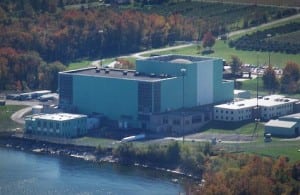The Nukes-Greenhouse Connection in New York
February 24, 2014 – Here’s an interesting conundrum, posed by UBS utility analyst Julien Dumoulin-Smith in a recent report sent to his clients: If anti-nuclear and economic forces succeed in closing several nuclear plants in the New York in the near term, it could cripple the state’s plans for reducing greenhouse gas emission and devastate the regional cap-and-trade program, known as the Regional Greenhouse Gas Initiative, or RGGI (pronounced like the first name of Baseball Hall of Fame New York Yankee Reggie Jackson).
Environmental activists have been pushing for more than a decade to close Entergy’s Indian Point plant on the Hudson River some 35 miles north of New York City. Many who follow these issues, including an anonymous source of mine with very close ties to Entergy, predict that the New Orleans-based utility generator and New York Democratic Gov. Andrew Cuomo this year will agree to a deal to shut the plant.
Closing Indian Point – increasingly likely – will increase the state’s carbon emissions by around 26%, according to Dumoulin-Smith, “making any further nuclear retirements in the state unpalatable” because of the impact on the state’s greenhouse gas emissions.
Upstate, Exelon’s Ginna (pronounced gun-NAY) plant on Lake Ontario near Rochester is facing economic troubles and may be forced to shut down. (I was a cub reporter at the Rochester Times-Union when Rochester Gas and Electric announced it was going to build the plant and I wrote the front-page story for the paper.) Ginna, which went into service in 1970, is a single, two-loop Westinghouse PWR quite similar to Dominion’s Kewaunee plant in Wisconsin closed in 2012 on economic grounds. Also wobbling economically in New York are the Fitzpatrick and Nine Mile Point plants.

By Dumoulin-Smith’s calculations, taking down those Empire State nukes in a short time span would lead to dramatic increases in New York’s carbon dioxide emissions (because of fossil replacements), spiking carbon prices on RGGI, and making the state’s CO2 reduction goals “entirely unattainable.” Total state emissions, he says, would increase by at least 60% “and the entire RGGI region’s by ~25% or 22 million tons, a cause for wider regional concern.”
What’s the likely outcome of this scenario? Dumoulin-Smith says the “onus is on New York to step up to ‘save its nukes’ through extended bilateral contracts,” putting Exelon “in a favorable position to force the state to extent its looming contract with Ginna, which expires in June 2014.” The contract with the state-owned New York Power Authority is considerably above market. That might also happen with Nine Mile, also an Exelon unit. As for Fitzpatrick, Dumoulin-Smith says that Entergy’s “contentious relationship with the state over Indian Point leaves it ill-positioned to negotiate a contract over Fitzpatrick, but here too we see pressure to maintain the unit (also without a contract).”
In a broader context, Dumoulin-Smith says he sees “a growing need to address the contradictory effect of continued production-based incentives for wind generation and their corresponding negative impacts on nuclear units. The policy question remains: are renewables developed for the sake of ‘green’ or is there a broader ‘carbon mandate’ being pursued as well?”
The question is on the money. Don’t expect an answer anytime soon.